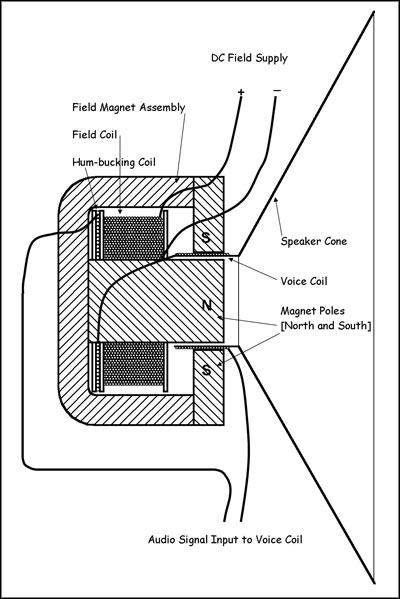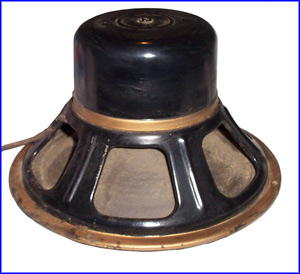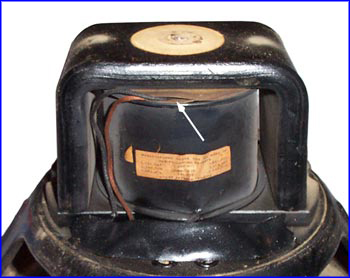The HAMMOND ORGAN
North Suburban HAMMOND ORGAN Service
The next items to look at are the typical loudspeakers that the Hammond company used in many of their speaker cabinets, or tone cabinets to use the correct terminology. A very common example is the electro dynamic speaker which I show in cross section below. The other type of speaker which they used, especially in their newer speaker cabinets is the permanent-magnet speaker. The only real difference between the two is that in the electrodynamic speaker, the necessary magnetic field to make the speaker work is created by direct current flowing through a multi-turn coil which is part of the field structure on the speaker. Permanent or PM speakers use a permanent magnet and dispense with the field coil and also the hum-bucking coil. Here is a cross section of an electrodynamic speaker. To make this simpler, I have left out the supporting frame or "basket" which holds everything in correct alignment and the speaker cone center suspension.
In operation, a steady direct current flows through the field coil, magnetizing the field structure as shown. The audio signal is applied to a small coil (called the voice coil) of wire wrapped on an insulated tube which is an extension of the speaker cone at the center as shown.

Figure 28. Diagram of electrodynamic speaker as used in many Hammond tone cabinets. This is a "cut in half" diagram, thus the coils are shown as tiny circles, as though you sawed the coil down the middle and looked at the actual ends of the wires that make up the various coils in the speaker.
The arrangement is such that the voice coil lies in the gap between the north and south magnet poles. When current flows in one direction through the voice coil, it creates a magnetic field which reacts with the field in the gap and makes the cone move slightly to the right. When the audio signal current reverses direction, it makes the cone move to the left. The audio signal is always an alternating current, so as the current fluctuates in response to the power amplifier's output signal, the speaker cone faithfully reproduces the variations of the audio signal as mechanical motion, and the large surface area of the cone effectively generates a sound wave which is a replica of the audio AC signal.
Figure 29.A very early Jensen A12 electrodynamic speaker used in most of the original Hammond tone cabinets. Overall view showing hermetically sealed field magnet assembly.

If there is even the slightest amount of 60Hz AC power ripple in the DC that is applied to the field coil, this would react with the voice coil and produce a slight 120 Hz hum in the audio output of the speaker.
In order to keep this from happening, there is a small coil of wire right behind the speaker field coil, and it is in series with the voice coil. If there is any AC "ripple" in the speaker field current or the speaker's magnetic field, this will, by transformer principle, induce a corresponding ripple current in this "hum-bucking coil." The hum-bucking coil is wired so that its output is applied to the voice coil in opposition to any speaker cone motion that might be induced by AC ripple in the field current. This effectively cancels the action of the slight field current ripple voltage and eliminates the otherwise noticeable resulting AC power line humming from the speaker.
In the newer PM speakers, there is no ripple in the field of a permanent magnet and thus no need for a hum-bucking coil. To my knowledge, These nice electrodynamic speakers are no longer manufactured because the new special alloys and compositions for magnets are much better now than they were many years ago. Nevertheless, you can produce very powerful magnetic fields by applying DC to a coil wrapped around iron or steel bars, and many Hammond aficionados and preservationists will have new replacement cones installed in existing ED speakers. Here you see two pictures of a Jensen model A-12, one of the preferred ED speakers which Hammond used for many years in their tone cabinets.

Figure 30. Interior close-up of the Jensen A12's field assembly showing main field coil (with label bearing patent numbers) and the hum-bucking coil, [white arrow].
Notice also that there is no need for any treble speakers or tweeters in Hammond tone cabinets. Because the highest available frequency is only 6kHz and also because Hammond didn't want to have the key clicks emphasized, there was no reason to install speakers to handle any frequencies in excess of 6 kHz.
Figures twenty-nine and thirty give you an idea of what a typical electrodynamic speaker looks like. These units were excellent, could take a lot of power, were very conservatively rated and handled the entire range of a typical Hammond without any problems.
In many roller skating rinks, the Hammond speaker system would also be used for the playing of records and tapes and also as a PA system. Generally, the results obtained by doing this were excellent. Hammond tone cabinets could perform double-duty as a good quality PA system. Unfortunately, the converse of this was not always true. Some skating rinks tried to economize by using a general PA system for the Hammond also. Most of these were moderately to significantly unsatisfactory. A speaker system for producing music is quite different from one designed to reproduce music, as some rink operators learned after presumably saving money by not installing the proper sound system to meet the requirements of their Hammonds. It is also interesting to note that the Hammond was just about the only electronic ever installed in rinks; experience proving that few others could stand up to the demands of rink service, including high levels of dust from floor rosin in roller rinks, and high ambient moisture in ice rinks.
These speakers were always mounted in speaker cabinets, however. A little thought on how a speaker operates will tell you that the cone produces a sound wave from both sides, and by the very nature of the speaker and its operation, these two sound waves are 180 degrees out of phase, which means that they will very effectively cancel each other. If the wavelength of the soundwave is short, [less than the radius of the speaker cone] cancellation will be markedly reduced, however in the case of bass tones which have soundwaves many feet long, no bass could be produced at all unless the speaker was enclosed in a suitable cabinet to provide significant separation of these two out-of-phase sound waves. This rule holds true even with today's modern speakers, which is why speakers are always enclosed in some type of cabinet. In the typical Hammond speaker cabinet, these speakers can produce bass that you can feel as well as hear; the secret lying significantly in the design of the enclosing tone cabinet.
The next and final item which we will look at concerning the typical Hammond organ is the power amplifier which takes the minute signal from the console and raises its power to a sufficient level to drive these speakers to the point that they can rattle walls and windows if you really want to push up the Hammond's volume.
Previous page Page 18. Next page